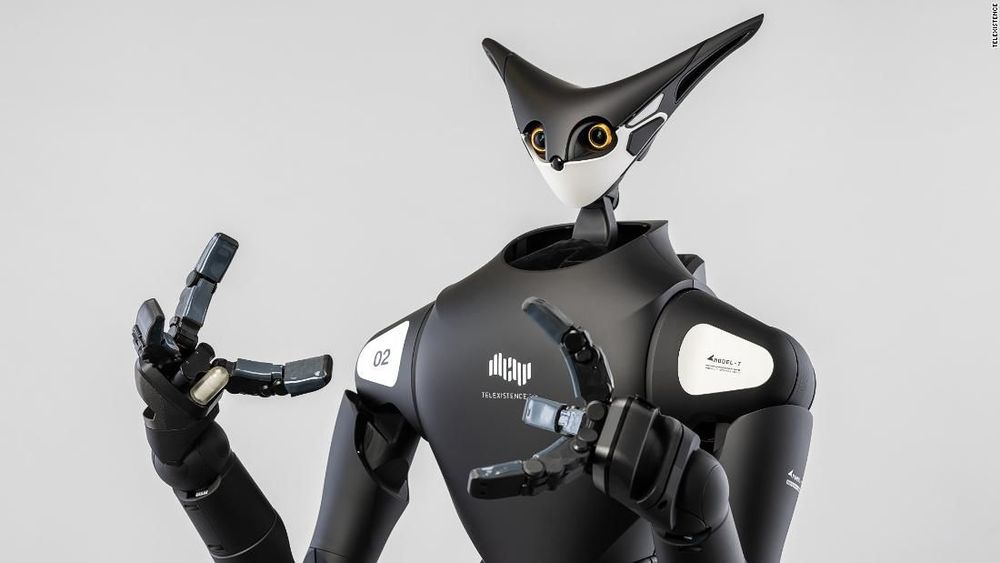Robot Babe.
Category: food – Page 216

Remote-control VR robots to start working in Japanese convenience stores this summer
Family Mart’s robots will still be controlled by human employees.
Hardly a day goes by that we don’t find ourselves stopping into one of Japan’s many convenience stores to grab a bite to eat or something to drink. But while we’ve come to expect tasty onigiri rice balls and tempting dessert beverages when we walk through the door, soon we might be seeing robots.

World War III will be fought over water
RS: The third world war is at our gate, and it will be about water, if we don’t do something about this crisis. These walks are to raise awareness—this year we covered 17 countries, and in nine of them there were displaced people. So many people in the Middle East and African countries are moving to places like Europe, in part because of water scarcity—after forced migration comes, tension, conflict, and terrorism. Where terrorism is active, there is usually a scarcity of water. Look at Syria—a long time ago, it had very good agriculture, but then Turkey built a dam that changed things. It’s a similar story with Libya. If we want a safe future, we need to start conserving water.
What role can regulation play in conservation? Do you think privatizing water is a good way to promote its efficient use?
RS: If we really think about legal changes, we have to first think about river rights, or the rights of nature, and only then about water rights for humans. This type of thinking doesn’t exist today but we need this kind of legal framework that assures that the land of the river is only for the river, that the flow of the river is kept clean, and that the river has greenery on both banks to prevent erosion and silting. Only with all these factors can we ensure that rivers are healthy and only then that we are healthy.


Seven-foot robots are stacking shelves in Tokyo convenience stores
This robot on wheels is seven feet tall, is kitted out with cameras, microphones and sensors, and uses the three “fingers” on its hands to stock supermarket shelves with products such as bottled drinks, cans and rice bowls.
Japan’s convenience stores are turning to robots to solve their labor shortage.
The End of Hunger Part 1: Vertical Farming
World hunger is a persistent problem despite all of humanity’s progress in recent years. However, I believe that we have a real shot at defeating world hunger with one of humanity’s newer innovations: vertical farms.
Discord Link: https://discord.gg/brYJDEr
Patreon link: https://www.patreon.com/TheFuturistTom
Please follow our instagram at: https://www.instagram.com/the_futurist_tom
For business inquires, please contact [email protected]
TECHNOCULTURE: The Rise of Man | The Cybernetic Theory of Mind
What has been shaping the human mind throughout the history of mankind? What is the difference between mind and consciousness? What links quantum physics to consciousness? What gives rise to our subjective experience? What drives our accelerating evolution?
If you’re eager to familiarize with probably the most advanced ontological framework to date or if you’re already familiar with the Syntellect Hypothesis which, with this series, is now presented to you as the full-fledged Cybernetic Theory of Mind, you should get this book two of the series which corresponds to Part II of The Syntellect Hypothesis: Five Paradigms of the Mind’s Evolution. This volume two contains some newly-introduced and updated material if compared with the originally published version and can be read as a stand-alone book. At the same time, it is highly recommended to obtain The Syntellect Hypothesis as the original coherent version of the same theoretical framework instead of waiting for all five books to come out and if you don’t need extra detailing.
Over the course of human history, from the first bonfire to today’s smartphones and hyperloops, we have designed tools, and tools designed us back by shaping our minds. Technology isn’t just something outside ourselves, it’s an innate part of human nature, like sex, sleeping or eating, and it has been a major driving force in evolution. Tool using, along with language, bipedalism, and cooking (quite literally) is essentially what has made us human.
Inaho’s tireless asparagus picking robot
This autumn Kotaro Ando, a forty year-old farmer from Tara Town, Saga City (Japan) became the first customer to lease an asparagus picking robot from local agricultural high-tech startup Inaho Co. Ltd. Founded in 2017 and located in the coastal town of Kamakura, Inaho develops robots for agricultural and non-agricultural use. In January 2019, the company opened an office in Kashima (about 110 km from Tokyo) to market their autonomous robot to asparagus and cucumber farmers in Saga City and its surrounding areas. Kotaro Ando was one of these lucky asparagus farmers.
Mysterious ‘Blob’ With 720 Sexes And Ability To Learn Will Be Unveiled In Paris
The blob is neither animal, plant, nor fungus. The remarkable species can find and digest food, form together with others, and pass on knowledge.
Linking calorie restriction, body temperature and healthspan
Cutting calories significantly may not be an easy task for most, but it’s tied to a host of health benefits ranging from longer lifespan to a much lower chance of developing cancer, heart disease, diabetes and neurodegenerative conditions such as Alzheimer’s.
A new study from teams led by Scripps Research Professors Bruno Conti, Ph.D., and Gary Siuzdak, Ph.D., illuminates the critical role that body temperature plays in realizing these diet-induced health benefits. Through their findings, the scientists pave the way toward creating a medicinal compound that imitates the valuable effects of reduced body temperature.
The research appears in Science Signaling.